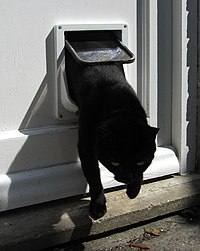Cat flap



A cat flap or cat door is a hinged flap set into a door, wall or window to allow cats to enter and exit a house on their own without needing to solicit help from a human, while offering a degree of protection against wind, rain, and larger-bodied intruders entering the dwelling. Dog doors similarly exist for dogs.
Cat flaps are popular in some countries, particularly the United Kingdom where it is believed that about 90% of cats have access to the outdoors.[1]
In the rural areas, cat doors were set into doors, walls or roofs of houses to welcome cats and thus keep away rodents from flour and corn storage spaces. Nowadays, this function is mostly lost but in some rural areas like Rincón de Ademuz (Valencia, Spain) cat doors can still be found.
Etymology
The Oxford English Dictionary records the first use of cat flap in 1957 and the first use of cat door in 1959.[2]
History
The invention of the cat flap is attributed to Isaac Newton in a story by a "Country Parson" to the effect that Newton foolishly made a large hole for the mother and a small one for the kittens, not realizing the kittens would follow the mother through the large one.[3] Two Newton biographers cite passages saying that Newton kept "neither cat nor dog in his chamber"[4] J. M. F. Wright, writing in his memoir Alma Mater in 1827, was an inhabitant of Newton's 'set' in Trinity and reported this same story, adding "Whether this account be true or false, indisputably true is it that there are in the door to this day two plugged holes of the proper dimensions for the respective egresses of cat and kitten."[5]
Features
The simplest cat flaps are just weighted flaps, but these may be blown open or may rattle in the wind. A magnet on the flap can hold the door in place and allow access. Some flaps also have adjustable catches to restrict the opening of the flap in one direction or the other — for example to allow the cat to come in, but not go out again. More sophisticated flaps have electromagnetic catches that can detect a matching permanent magnet worn on the cat's collar that will unlock the flap as the cat approaches, thus preventing any other animals from using the flap and entering the house. Flaps with infrared locks open only when a collar-mounted device transmits the correct code to the flap, allowing cat owners to have multiple flaps that different cats can use.
RFID cat flaps which read a cat's microchip implant rather than the cat having to wear a collar have been available in Europe for several years, but were not distributed in the United States until recently.[6][7]
Some cats can circumvent one-way flap-mounted-in-flap designs by pulling at the bottom of the inner flap.
References
- ^ "Indoor / Outdoor". Messy Beast. Retrieved 2009-08-15.
- ^ Oxford English Dictionary. (full ed.) 2005.
- ^ "The monthly religious magazine". p. pg 298.
{{cite web}}:|page=has extra text (help); Unknown parameter|Volume=ignored (|volume=suggested) (help) - ^ Sir Isaac Newton, By S. Brodetsky, pg 100; Isaac Newton: a biography, by Louis Trenchard More
- ^ Alma Mater, Vol.1, p17
- ^ "Sureflap Europe". Sureflap.co.uk. Retrieved 2009-08-15.
- ^ "Sureflap North America". Sureflap.ca. 2009-07-01. Retrieved 2009-08-15.
